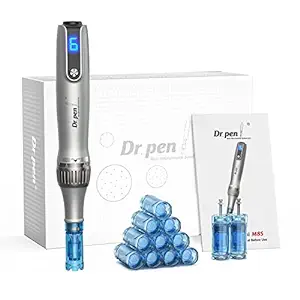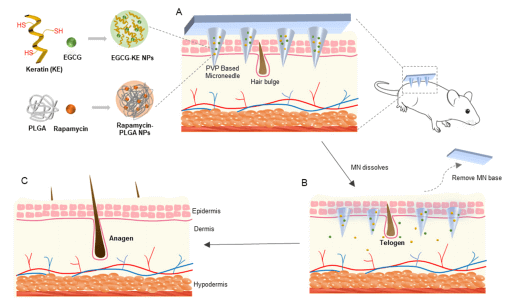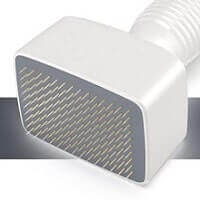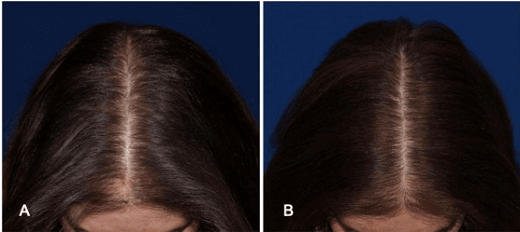
Microneedling (collagen induction therapy) entails wounding and skin disruption to induce hair growth and regeneration. In my prior posts on Follica, people often made informative comments about at-home microneedling and dermarolling for hair growth.
Update: March 2023
On a related note, a new scalp microinfusion technique from Portugal promotes drug delivery via micro-needling using a professional tattoo machine. It is known as the the MMP® technique. MMP is the Portuguese acronym for microinfusion of drugs into the skin. The researchers used a tattoo machine and cartridges containing 27 needles with a diameter of 0.3 mm and tip length of 5.5 mm. The needling depth was set to 300 microns and the frequency to 120 Hz. They injected Minoxidil into the scalp of balding patients to successfully promote hair growth.
Update: September 2022
Please let me know when this study on topical Dutasteride and microneedling is released in its entirety. It is based on a randomized controlled trial.
Microneedling for Better Drug Delivery
A really interesting study from China was published in July 2022. The researchers found that transdermal delivery of Rapamycin and Epigallocatechin Gallate (EGCG) nanoparticles with dissolvable microneedles led to significantly increased hair growth in mice. More here. Of interest:
“Rapamycin groups demonstrated more rapid hair growth, while EGCG groups had higher follicle density. The best results were achieved with a combination of rapamycin and EGCG.”

According to the authors, microneedling can break the barrier of the stratum corneum through puncturing. This ultimately improves drug delivery efficiency. Note that this microneedling process is not the same as at-home microneedling, but there has to be some commonality of intentional wounding.
We have seen other such studies in the past, but this is the first one to utilize non-hair loss drugs. Make sure to read my post on NAD, NMN and Dr. Sinclair, where I also touch upon Rapamycin.
Fake Dermaroller Warning
One of this blog’s valuable e-mail correspondants sent me the below lengthy message that I decided to paste after minor changes and corrections. I am not sure if the linked videos are biased by their sale of dermaroller products. I can also not vouch for the 95 percent “fake” estimate, considering that I have never microneedled or dermarolled my own scalp.
Moreover, some of the most popular demarollers on sale on Amazon have worked for many people per ratings and comments on hair loss forums, Discord and more. So perhaps some people just get lucky and even a slightly “off” or fake product also works?
Readers please let me know what you think in the comments to this post. At some point I might move this subject to the bottom of this post, underneath the original dermaroller section.
“You really might want to dig into the matter of fake dermarollers and shed light on this major topic, considering your large audience. Most people (probably yourself included and most dermatologists for sure) aren’t aware, but at least 95% of dermarollers sold on the internet are fake. I myself think this is the main reason why most people don’t get results when dermarolling, or even damage their hair.
Some related videos you should watch:
- https://youtu.be/q6IXraYOInQ (interesting experiment on a banana skin with real and fake dermarollers).
- https://youtu.be/hyyAJb0tEug
- https://youtu.be/LR-eseU90ls
The main difference is that the fake dermarollers have 540 “needles”. Moreover, these are actually spikes cut from cheap metal wheels, but this is often only visible by breaking the dermaroller. So consumer can never see the truth. The real ones have 192 needles.
However, some companies try to fool buyers by creating fake metal dermarollers with 192 needles (my previous one was fake despite my watchfulness). The ideal is to order a dermaroller on which the needles are visible through the roll.”
Update: January 5, 2022
New Microneedling and Hair Loss Studies
- A January 2022 study from China reported that micro-injury induces hair regeneration (and vitiligo repigmentation). The mechanism of action is via the Wnt/β-catenin pathway.
- In January 2022, a study from India concluded that microneedling monotherapy increased total hair count more than topical minoxidil 5%. The combination of the two was even more effective.
- A June 2021 study of interest, albeit not exactly related to at-home microneedling: Ceria nanozyme-integrated microneedles reshape the perifollicular microenvironment for androgenetic alopecia treatment.
- In February 2021, a study from Korea found that a newly developed home-use microneedle device enhanced the penetration of 5% Minoxidil. Patient self-assessment scores showed the highest satisfaction in the Minoxidil + Microneedling combination treated group. However, the excess hair count in this cohort after 6 months treatment (twice per week) was not statistically significant.
- In December 2020, an interesting letter summarized a pilot study on using Follica’s proprietary microwounding device to treat female pattern hair loss (FPHL). The results were very positive, and I covered them in detail here.
- A September 2020 study from Iran concluded that microneedling at a depth of 0.6 mm was more effective than at a depth of 1.2 mm. This is quite surprising, since most doctors and hair loss sufferers tend to recommend the higher number. For example, in the below video from 2020, the doctors suggest derma-rolling or micro-needling at a depth of 1-1.5 mm.
- A June 2020 study from China found Microneedling and Minoxidil combination treatment to be superior to either one by itself. The underlying mechanism involves activation of the Wnt/β-catenin signaling pathway.
Below is a great video from Dr. Gary Linkov. He recommends starting with 0.5 mm needle depth. Consult your doctor if you develop any scarring or other side effects.
December 25, 2019
My original post on using dermarolling in combination with Minoxidil was published all the way back in 2013. More evidence on the benefits of microneedling for hair loss reversal came in 2017, courtesy of Dr. Rachita Dhurat.
At-Home Microneedling for Hair Growth
Intentional scalp injury and wounding has been known to induce follicular neogensis via stimulating the dermis’ natural wound healing process. Over the years, there has been a lot of online discussion about DIY at-home microneedling and dermarolling to treat androgenetic alopecia.
I was planning to write a post on this subject in the past, but kept delaying it till today. For one, there are numerous hair loss forum and Reddit threads on this subject running into 100s of pages. Moreover, when it comes to microneedling for facial skin rejuvenation related applications, there is even more information available online. Including numerous reviews and before and after photos.
According to a summary of papers on microneedling, the procedure can help numerous dermatological conditions. These include skin rejuvenation (via increases in collagen and elastin); reduction of acne scarring, wrinkles, fine lines, stretch marks and surgical scars; improvement in undesired skin color changes such as melasma; and enlarged pore reduction. Note that in 2016, a Japanese research team found age-related hair loss to be caused by reduced collagen.
An increasingly common use entails using microneedling or skin puncturing for better transdermal drug delivery. In the hair loss world, many doctors and surgeons are using microneedling in tandem with application of hair growth serums, Minoxidil, PRP and Exosomes.
Needle Depth, Device Choice and Safety
Among the key questions when trying out at-home microneedling on the head:
- What is the appropriate depth of needles for microneedling on the scalp for hair growth? For thinner facial skin uses, fine needles of 0.25 mm and 0.5 mm depth seem to be preferred. For thicker scalp skin, many people recommend 1.5 mm to puncture the skin and epidermis sufficiently. Reader “PinotQ” mentioned a possible treatment regimen of 1.5 mm once a week, and 0.5 mm daily for maintenance. A September 2020 study from Iran found a depth of 0.6 mm to be more effective than a depth of 1.5 mm.
- What device is the best? There are hundreds of dermarollers and dermapens on sale online. A large number of those seem to have great reviews. It seems like most people prefer dermarollers to dermapens when it comes to the scalp, although the lower price of the former could be a factor. While the dermaroller needles enter the skin at an angle, dermapen needles enter vertically. Each device and delivery method has advantages and disadvantages.
- Safety precautions, including: making sure that the needles are sterilized and clean to prevent infection; not using too much force when rolling the device to avoid damaging the dermis; aftercare and cleaning up correctly in case of bleeding or other skin injury.
- How often to use the dermaroller or other micro needling device? Can one get away with just once a week treatment? Note that some people may easily bleed or have overly sensitive scalps, making microneedling impractical or even dangerous. For those with seborrheic dermatitis or psoriasis of the scalp, it is best to consult a dermatologist before starting treatment.
Dermarollers and Dermapens

Dermarollers work via a rolling head of hundreds of stainless steel needles that prick the skin.
Derma rollers are very cheap on Amazon. However, sizes range from needle depths of 0.25 mm to 0.5 mm to 1.5 mm. The rolling drum size can also vary significantly. You will need to read the comments to this post before deciding on the best product (s) for scalp hair growth purposes.

Many people also use handheld motor powered dermapens (more expensive) for microneedling. These are also known as micropens. Dermapens are handheld devices that work via oscillating pulses that rapidly move the needle up and down the treatment area. Unlike derma rollers that move horizontally across the skin, dermapens move vertically.
For more information, see this article on dermaroller versus dermapen. These two devices are also sometimes termed as microneedling roller v/s microneedling pen.
Dermastamps

An alternative product that some people praise is called the dermastamp (or derma stamp).
A popular one from Dr. Pen contains 140 titanium needles. As of today, it has been reviewed 130 times and holds a decent 4.4 out of 5 stars rating.
User Reviews on Microneedling at Home
Ultimately, the point of this post is to benefit from crowd-sourced reader comments about this subject matter all in one place. I might even start microneedling myself in 2020 if I get more motivated after reading about people’s experiences.
Follica’s recent statement seems to indicate that many kinds of wounding and skin injury can regenerate hair. Follica’s tried and tested in-office version and device will likely be the most effective. But for the time being, at-home use will have to suffice.
If you find any links to microneedling before and after hair growth photos, please post them in the comments.
